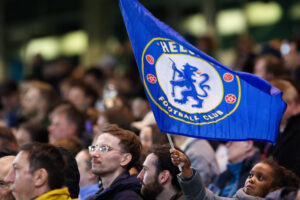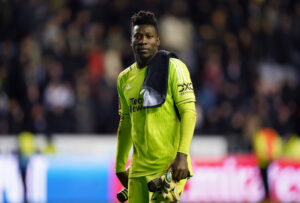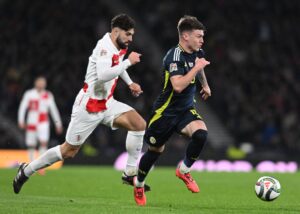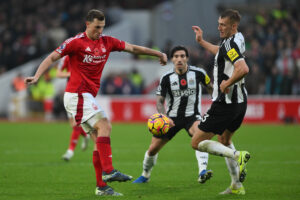If nothing else, Seamus Coleman’s horrific (and for once the use of that word is entirely justified) leg-break in Ireland’s World Cup qualifier against Wales last week reminded us exactly why footballers are entitled to earn so much money – it’s because their career could be over at any moment. It is to be sincerely hoped that this will not be Coleman’s fate, but if it is at least he should be financially secure for the rest of his life.
Five Injuries That Changed Football History
However, the most impactful (and the pun is very much intended) of injuries are those that not only affect an individual player, or even a team, but the whole sport. Here are five injuries that changed football history. Collectively, they have decided the fate of league titles, European Cups and even World Cups, and in at least one case they led to a change in the rules of football and the very nature of the game.
Dion Dublin’s broken leg in 1992
Dion Dublin – star striker, home-hammerer and “Dube”-inventor (it’s a percussion instrument and not an illegal cigarette) – often jokes that he is the man who made Sir Alex Ferguson, setting him on his way to glory at Manchester United and securing him a knighthood in the process. As with all the best jokes, there is a grain of truth in it. Unfortunately for Dublin, it was not his own footballing efforts that set Ferguson on the way to managerial greatness at Manchester United, but the broken leg he suffered within months of joining the club, which ultimately prompted the signing of Eric Cantona to replace him.
Dublin had first attracted Ferguson’s interest when, along with Steve Claridge, he was one of the main strikers of John Beck’s Cambridge United side, a team that refined “route one” football right down to its simplest components. With Dublin and Claridge forming a fearsome double-act up front, Cambridge rose through the divisions, but when they failed to make the final step up to the old First Division, just as it was about to become the Premier League in 1992, Dublin sought a move and he was probably as surprised as anyone when Manchester United came in for him.
A quarter of a century on, it is fascinating to reflect on how beleaguered Ferguson was when the Premier League era began (1992-93 being its first season). The previous season, he had somehow failed to win the final-ever First Division title, virtually ceding the league to bitter rivals Leeds United when Manchester United suffered a late-season collapse. Consequently, he was under huge pressure to go one better the following year, but few people believed that signing Dublin was the way to go about it.
Indirectly, of course, it was. Dublin scored the goal that secured Manchester United’s first-ever Premier League win, at Southampton, but he had done precious little else to suggest that he was the new Best or Law before he broke his leg in a 1-0 home win over Crystal Palace, after a typically tough tackle from classic “old-school” centre-back Eric Young, and was ruled out of action for at least six months. United struggled on without him, but at the end of the year Ferguson came up with what at the time seemed like a mad last throw of the dice but history has shown to be a masterstroke, signing Eric Cantona from the same hated rivals, Leeds, after their manager, Howard Wilkinson, had initially inquired about signing Denis Irwin.
In signing Cantona, Ferguson, who as a player had been a typically rough-hewn Glaswegian centre-forward, found the superbly skilled striker he had always dreamed of being and “Eric Le Roi” duly led United to their first league title in 26 years, the first of 13 in total (along with two European Cups) that Ferguson won over the next two decades.
Much is rightly made of Mark Robins’s 1990 FA Cup goal against Nottingham Forest being the “turning point” for Ferguson after a difficult, trophy-less first few years at United, but it is often forgotten that he was under at least as much pressure, if not more so, when he lost the title to Leeds two years later. If Dublin, who thankfully recovered sufficiently to have a fine career with Coventry, Aston Villa and England, had not broken his leg, Ferguson would almost certainly never have signed Cantona and football history would have been very different. Who knows? United could now be waiting for their first title in 50 years.
Jimmy Greaves’ shin injury at the 1966 World Cup
With apologies to Gary Lineker and Michael Owen, Jimmy Greaves is undoubtedly the finest natural goal-scorer England has produced since World War Two. (Dixie Dean, who of course flourished for Everton and England before World War Two, is probably his only genuine challenger in the all-time stakes.) However, whereas Lineker and Owen both starred at World Cups – Lineker top-scoring at Mexico ’86 before leading England to the semi-final at Italia ’90, and Owen scoring one of the greatest ever individual World Cup goals at France ’98 – Greaves was ultimately denied the opportunity to shine on football’s biggest stage. And yet if he had not suffered injury early on in the 1966 tournament, Alf Ramsey’s England might never have won the World Cup.
Greaves’s goal-scoring feats ever since he had been a teenager were already the stuff of football history and folklore by 1966, when England were preparing to take on the world on home soil. As a teenager, he had broken through with Chelsea in the late 1950’s, before enjoying a brief period with AC Milan, during which he still scored a respectable number of goals even in Italy’s ultra-defensive Serie A.
However, it was on his return to England with Tottenham in 1961 that he really came into his own. He may have missed out on being part of the great double-winning side of 1960-61, but in the next two seasons he helped Spurs retain the FA Cup and then become the first English club to win a European trophy, the 1963 European Cup Winners’ Cup, scoring twice in the final against Atletico Madrid. In between, he led the line for England at the 1962 World Cup in Chile, scoring once before England were defeated by Brazil, the reigning world champions who would go on to retain their title in Santiago.
Four years later, when England were World Cup hosts, Greaves was the great hope of Englishmen everywhere. He had continued to score seemingly endlessly for Spurs (in the nine years he was with them from 1961, he scored more than 200 goals in just over 300 games) and his England scoring record was scarcely less impressive. Consequently, when Alf Ramsey famously promised that England would win the World Cup for the first time, it seemed inconceivable that they could do it without Greaves.
Of course they did, after Greaves suffered a gash to his shin in the final group match against France that required stitches and left a permanent scar – and not only physically. In Greaves’s absence for the quarter-final against Argentina, his replacement, Geoff Hurst, a fine, physical centre-forward who was particularly good in the air but who had none of Greaves’s natural genius, scored the winner and retained his place for the next round and the final, famously scoring a hat-trick in the final, which eventually won him a knighthood.
It is, of course, impossible to know how England might have fared in 1966 if Greaves had not been injured, but the team certainly seemed galvanised in his absence, with Hurst’s hard-working, hard-running style a more natural fit for Ramsey’s “wing-less wonders” than Greaves’s languid, graceful style. And as is often the way in football, perhaps in the absence of their star man (as Greaves undoubtedly was then, even ahead of Bobby Charlton) the other players collectively raised their game to the point where they became invincible, at least for that one glorious month.
Greaves, of course, was not knighted and infinitely more importantly he never fully recovered from the disappointment of missing out on the biggest game in his or any other player’s life. To this day, he remains a kind of footballing “ghost at the feast”, the brilliant individual who could not quite fit into the relentless teamwork that Ramsey demanded. He was never the same player again, with his international career ending the following year, and indeed he was never quite the same man, as the previously happy-go-lucky, self-confessed “cheeky Cockney chappie” ended up sliding down the footballing ladder before succumbing to full-blown alcoholism. The disease consumed him for the next two decades before he cleaned up, dried out and made an unlikely comeback as a footballing pundit and the “Greavsie” to Ian St. John’s “Saint”.
Ferenc Puskás’ injury in the 1954 World Cup
If the effect of Jimmy Greaves’s injury in 1966 can be said to have been ultimately positive on England, the reverse is true of the injury that afflicted Ferenc Puskás in 1954. Ultimately, it cost Hungary the World Cup and arguably altered football history forever. If Puskás had not been kicked out of the 1954 tournament, Hungary might now be celebrating becoming world champions for a fourth time while Germany continue to languish in the footballing backwaters, and it is even conceivable that the Cold War might have turned out very differently indeed.
Hungary in 1954 were about as warm as World Cup favourites can get without actually catching alight. The “Mighty” or “Marvellous” Magyars, as they were called, were a collection of star talent unrivalled in the country’s footballing history and arguably in any other country’s footballing history, even that of five-time world champions Brazil. Led by the great Gusztáv Sebes, who was instrumental in overseeing football’s tactical evolution from attack-heavy formations to a more balanced 4-2-4, they featured such stellar players as goal-machine striker Sándor Kocsis and famously deep-lying centre-forward Nándor Hidegkuti. But without a doubt the jewel in this most glittering of crowns was their captain, most gifted player and Billy Wilder lookalike (just add glasses), Ferenc Puskás.
However, like Jimmy Greaves 12 years later, Puskás was injured in the final group stage match, which, unlike in 1966, was a precursor of the final. West Germany (Germany obviously having been divided into East and West after WWII) were playing in their first major international tournament since the end of the war and were easily dispatched by Hungary, who won 8-3. However, not only had canny German coach Sepp Herberger rested some key players for that group stage match, banking on Germany’s ability to win their ensuing play-off against Turkey (which they did), but, intentionally or otherwise, German defenders injured Puskás. He suffered a hairline fracture of his ankle which kept him out of Hungary’s quarter-final and semi-final games, but returned for the final, which once more set Hungary against West Germany.
What followed in the final has been written about brilliantly by Brian Glanville, the doyen of football historians, in his history of the World Cup and celebrated on film in the 2003 German film, The Miracle of Bern. The final was certainly a remarkable turnaround from the group game, as West Germany, inspired by their star striker Fritz Walter (who, like many of their players, had fought in and survived the war), won 3-2.
However, it remains probably the most controversial of all World Cup finals, as Hungary, even with the still-injured Puskás little more than a passenger, scored what seemed like a late equaliser, only for it to be controversially ruled out. To this day, Hungarian football fans (or at least the members of the older generation who remember the game) claim that they were denied their rightful victory because the West wanted a “western” winner and were not prepared to countenance a Communist world champion, with all the propaganda possibilities that that would have provided for the old Soviet Bloc.
Whatever the truth of that claim (and after more than 60 years it is probably impossible to prove or disprove definitively), what is unarguable is that if Puskás had remained fit throughout the tournament (perhaps having been rested in the “dead rubber” against West Germany in the group stage) Hungary would almost certainly have won the World Cup and football history, and perhaps even world history, would have been very different.
Brian Clough’s career-ending injury in 1962
It is often said of Brian Clough that he “broke the mould”, in that there is no-one, not even Jose Mourinho, who can ever match his feats as either a manager or an orator. However, it can also be said of Clough that he himself created a mould, or at least established a template, for a successful football manager – that of a gifted player whose career was ended by injury and who consequently has to fulfil himself off the pitch in a way that he had been unable to on the pitch. Even today, it is true of such rising managerial stars as Bournemouth’s Eddie Howe or Hoffenheim’s Julian Nagelsmann.
But whatever either of them achieve in football (and they are both among the favourites to replace Arsène Wenger at Arsenal, whenever he finally quits the Emirates), they will do well to get anywhere near the achievements of Clough.
The film adaptation of David Peace’s novel, The Damned United, a semi-fictionalised account of Clough’s 44 days in charge of Leeds United in 1974, was criticised for inaccuracy by many in football, particularly those Leeds players who felt that they had been misrepresented. However, the original novel is one of the most extraordinary pieces of writing about football, especially its opening, which successfully gets inside the head of Clough as he starts out as a manager and ruefully reflects on the events of Boxing Day 1962.
That was when, playing for Sunderland against Bury at Roker Park (Sunderland’s old ground), he collided with an onrushing goalkeeper and suffered extensive damage to the ligaments in his right knee. What today would be a relatively routine injury that would keep a player out for a few weeks or at worst months was at the time career-ending.
In The Damned United, Peace depicts a Clough who is almost trapped inside his head after the injury that prevented him from playing football any more. And he had been a fine player, a free-scoring centre-forward for first Middlesbrough and then Sunderland who may have spent much of his career in the old Second Division but none the less won England caps. However, the injury ended Clough the player and whereas almost any other player with his goal-scoring record might have reflected on an otherwise successful career, Peace shows how Clough became so driven to succeed as a manager (not least because, unlike now, a player could not afford to retire at the end of their playing career) that within a decade he had led Derby County to the First Division championship and within two decades he had not only won the European Cup with Nottingham Forest but retained it.
If Clough had not suffered what at the time was an appalling, career-shattering injury, it is extremely unlikely that he would ever have developed into the managerial great – correction, managerial greatest – that he went on to become. And if he had not showed that it was possible to recover from an unfulfilled playing career by having a truly unbelievable managerial career, the likes of Howe and Nagalsmann might have found it impossible to follow his lead.
Diego Maradona’s injury by Andoni Goikoetxea in 1983
Undoubtedly the most infamous and arguably the most important foul in football history was committed by Andoni Goikoetxea of Athletic Bilbao against Diego Maradona on 24 September 1983, when the Argentine genius was playing for Barcelona.
Indeed, as has often been said since, “foul” is far too polite a word; “assault” would be much more accurate and appropriate. Goikoetxea, a legendarily tough defender, literally launched himself into the back of Maradona from several yards away and broke his ankle. Even Maradona, who from his earliest playing days in Buenos Aires had become used to evading the most aggressive actions of defenders, was unable to escape Goikoetxea, who subsequently and justifiably became known as “The Butcher of Bilbao”, a nickname that was memorably reduced even further in a GoalSoul T-shirt to the image of a butcher’s knife dripping with blood.
That one foul had enormous consequences, for both players and ultimately for the whole game of football. Maradona missed the next three months through injury, but even after he returned he was never able to fulfil his undoubted talent at the Camp Nou, which eventually led to his transfer to Napoli. There, in what is perhaps the only part of Western Europe that possesses both the material poverty and the footballing fervour of South America, Maradona completely fulfilled himself as a club player, winning Napoli’s first ever Serie A title in 1987, then a UEFA Cup in 1989 and finally a second Serie A title in 1990.
Ironically, Maradona’s last ever game for Barcelona was a Spanish Cup final played at their home ground, which they lost 1-0 to Bilbao and which ended in a mass brawl with Maradona, perhaps seeking revenge against Goikoetxea, trying to confront the defender, only to receive a kick to the chest for his troubles, as a parting gift from the “Butcher of Bilbao” in particular and Spanish football as a whole.
So Maradona lost his battles against Goikoetxea, but ultimately he – and football itself – won the war. That was because as a result of Goikoetxea’s apparently deliberate mangling of the player who at the time was the world’s finest, UEFA and FIFA finally decided to call time on the dreaded “tackle from behind”. Allowed in the game for most of its history, by the time Goikoetxea and his ilk (such as Italy’s Claudio Gentile, who had been far more clandestine in kicking Maradona out of the 1982 World Cup) were employing it in the late 1970’s and 1980’s it was more like a kung-fu or karate kick from behind than a mere tackle.
Consequently, when the tackle from behind was finally outlawed by FIFA in 1998, nearly 15 years after Maradona had suffered from the ultimate example of it (such was the swift pace that FIFA moved at in the era of Blatter), it marked a definitive end to what was undoubtedly the worst tackle in football, precisely because it could be committed without the player being tackled knowing it was coming.
Endless comparisons are drawn between Maradona and the player commonly regarded as the finest player to grace a field since him, his fellow Argentine Lionel Messi. While Maradona may have ultimately won a World Cup in Mexico in 1986, when the likes of Gentile and Goikoetxea were no longer legally allowed to attack him, Messi is yet to win a World Cup for his country (and, after his ban for foul and abusive language this week, he may never do so). However, it is undeniable that Messi’s achievements at club level for Barcelona far outstrip those of Maradona for Napoli or anyone else. And yet Messi himself is one of the main beneficiaries of Maradona’s playing days, because if the tackle from behind had not been outlawed in the wake of Goikoetxea’s shocking assault in 1983 it is almost inconceivable that Messi would have been able to dance through opposition defences as he has done for the last decade.
In that sense, Goikoetxea’s act of “anti-football”, as it was described at the time, was ultimately good for the game.
Main Photo:






